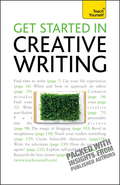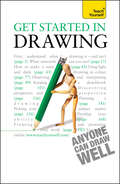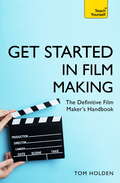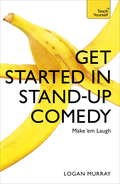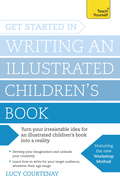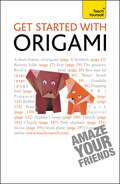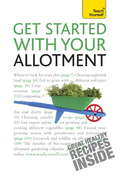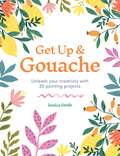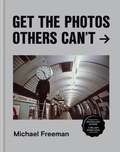- Table View
- List View
Get Started In Beekeeping: Teach Yourself (Teach Yourself General)
by Adrian Waring Claire WaringSuitable both for those just considering the prospect and those who are already fascinated beekeepers, this guide to setting up, maintaining and maximising bees in the back garden is an indispensable and readable bible of information and practical advice. It covers everything from bee behaviour to what to do with honey, and balances all the background context on bee biology with the day-to-day and seasonal practicalities of running hives in any location, in the country or the city, and for colonies of all sizes. Supporting resources include a 'bee calendar', troubleshooting section, illustrations, photos, a glossary and details of courses and organizations, in an essential guide for anyone who is fascinated by the ancient ways of the apiarist. NOT GOT MUCH TIME? One, five and ten-minute introductions to key principles to get you started. AUTHOR INSIGHTS Lots of instant help with common problems and quick tips for success, based on the authors' many years of experience. TEST YOURSELF Tests in the book and online to keep track of your progress. EXTEND YOUR KNOWLEDGE Extra online articles at www.teachyourself.com to give you a richer understanding of beekeeping. FIVE THINGS TO REMEMBER Quick refreshers to help you remember the key facts. TRY THIS Innovative exercises illustrate what you've learnt and how to use it.
Get Started In Creative Writing: Teach Yourself (Ty Creative Writing Ser.)
by Stephen MayGet Started in Creative Writing is an indispensible guide to unlocking your creativity, finding your voice and choosing a genre of writing that suits you best, whether fiction or non-fiction, short stories or novels, children's books or travel writing. It features guidelines for do's and don'ts along with suggestions for crafting a distinctive style.With tips from some of the best-known writers of fiction and non-fiction, you will receive loads of helpful advice to enable you get your own work published.NOT GOT MUCH TIME?One, five and ten-minute introductions to key principles to get you started.AUTHOR INSIGHTSLots of instant help with common problems and quick tips for success, based on the author's many years of experience.TEST YOURSELFTests in the book and online to keep track of your progress.EXTEND YOUR KNOWLEDGEExtra online articles at www.teachyourself.com to give you a richer understanding of creative writing.FIVE THINGS TO REMEMBERQuick refreshers to help you remember the key facts.TRY THISInnovative exercises illustrate what you've learnt and how to use it.
Get Started In Creative Writing: Teach Yourself (Ty Creative Writing Ser.)
by Stephen MayGet Started in Creative Writing is an indispensible guide to unlocking your creativity, finding your voice and choosing a genre of writing that suits you best, whether fiction or non-fiction, short stories or novels, children's books or travel writing. It features guidelines for do's and don'ts along with suggestions for crafting a distinctive style.With tips from some of the best-known writers of fiction and non-fiction, you will receive loads of helpful advice to enable you get your own work published.NOT GOT MUCH TIME?One, five and ten-minute introductions to key principles to get you started.AUTHOR INSIGHTSLots of instant help with common problems and quick tips for success, based on the author's many years of experience.TEST YOURSELFTests in the book and online to keep track of your progress.EXTEND YOUR KNOWLEDGEExtra online articles at www.teachyourself.com to give you a richer understanding of creative writing.FIVE THINGS TO REMEMBERQuick refreshers to help you remember the key facts.TRY THISInnovative exercises illustrate what you've learnt and how to use it.
Get Started In Pig Keeping: How to raise happy pigs in your outdoor space
by Tony YorkIs this the right book for me?Everything an amateur pigkeeper needs for successGet Started in Pig Keeping offers amateur pigkeepers everything they need to make a success of this increasingly popular pursuit. Whether you are interested in breeding pigs, in meat production, or just want the pleasure of their company, this book covers legalities, basic equipment, picking breeds, understanding behaviour and how to raise and slaughter pigs. You'll get all of the advice you need on daily maintenance of your animal, from feeding to cleaning, and find ample resources if you wish to produce your own meat - or even market and sell it at a local level. Get Started in Pig Keeping includes:Chapter 1: The starting pointChapter 2: Preparation and knowing the rulesChapter 3: Before your pig arrivesChapter 4: Can keeping pigs be cost effective?Chapter 5: Getting your first pigChapter 6: Feeding your pigChapter 7: The health of your pigChapter 8: Breeding from your own stockChapter 9: Meat for the freezerChapter 10: Sales and MarketingChapter 11: Who's who in the pig worldLearn effortlessly with a new easy-to-read page design and interactive features: Not got much time?One, five and ten-minute introductions to key principles to get you started.Author insightsLots of instant help with common problems and quick tips for success, based on the author's many years of experience.Test yourselfTests in the book and online to keep track of your progress.Extend your knowledgeExtra online articles to give you a richer understanding of the subject.Five things to rememberQuick refreshers to help you remember the key facts.Try thisInnovative exercises illustrate what you've learnt and how to use it.
Get Started In Pig Keeping: How to raise happy pigs in your outdoor space
by Tony YorkGet Started in Pig Keeping offers amateur pigkeepers everything they need to make a success of this increasingly popular pursuit. Whether you are interested in breeding pigs, in meat production, or just want the pleasure of their company, this book covers legalities, basic equipment, picking breeds, understanding behaviour and how to raise and slaughter pigs.You'll get all of the advice you need on daily maintenance of your animal, from feeding to cleaning, and find ample resources if you wish to produce your own meat - or even market and sell it at a local level.NOT GOT MUCH TIME?One, five and ten-minute introductions to key principles to get you started.AUTHOR INSIGHTSLots of instant help with common problems and quick tips for success, based on the author's many years of experience.TEST YOURSELFTests in the book and online to keep track of your progress.EXTEND YOUR KNOWLEDGEExtra online articles at www.teachyourself.com to give you a richer understanding of pig keeping.FIVE THINGS TO REMEMBERQuick refreshers to help you remember the key facts.TRY THISInnovative exercises illustrate what you've learnt and how to use it.
Get Started In Pig Keeping: How to raise happy pigs in your outdoor space (Teach Yourself)
by Tony YorkGet Started in Pig Keeping offers amateur pigkeepers everything they need to make a success of this increasingly popular pursuit. Whether you are interested in breeding pigs, in meat production, or just want the pleasure of their company, this book covers legalities, basic equipment, picking breeds, understanding behaviour and how to raise and slaughter pigs. You'll get all of the advice you need on daily maintenance of your animal, from feeding to cleaning, and find ample resources if you wish to produce your own meat - or even market and sell it at a local level.
Get Started In Pig Keeping: Teach Yourself (Teach Yourself General)
by Tony YorkGet Started in Pig Keeping offers amateur pigkeepers everything they need to make a success of this increasingly popular pursuit. Whether you are interested in breeding pigs, in meat production, or just want the pleasure of their company, this book covers legalities, basic equipment, picking breeds, understanding behaviour and how to raise and slaughter pigs. You'll get all of the advice you need on daily maintenance of your animal, from feeding to cleaning, and find ample resources if you wish to produce your own meat - or even market and sell it at a local level. NOT GOT MUCH TIME? One, five and ten-minute introductions to key principles to get you started. AUTHOR INSIGHTS Lots of instant help with common problems and quick tips for success, based on the author's many years of experience. TEST YOURSELF Tests in the book and online to keep track of your progress. EXTEND YOUR KNOWLEDGE Extra online articles at www.teachyourself.com to give you a richer understanding of pig keeping. FIVE THINGS TO REMEMBER Quick refreshers to help you remember the key facts. TRY THIS Innovative exercises illustrate what you've learnt and how to use it.
Get Started in Beekeeping: A practical, illustrated guide to running hives of all sizes in any location
by Adrian Waring Claire WaringWritten by two of the UK's most well-known and respected experts in the beekeeping community, this is a new and updated edition of a popular reference title which contains everything the beginner, or even intermediate, beekeeper could need.Suitable both for those just considering the prospect and those who are already fascinated beekeepers, this guide to setting up, maintaining and maximising bees in the back garden is an indispensable and readable bible of information and practical advice. It covers everything from bee behaviour to what to do with honey, and balances all the background context on bee biology with the day-to-day and seasonal practicalities of running hives in any location, in the country or the city, and for colonies of all sizes. Resources include a 'bee calendar', troubleshooting section, illustrations, a glossary and details of courses and organizations, in an essential guide for anyone who is fascinated by the ancient ways of the apiarist.
Get Started in Drawing: Teach Yourself (Teach Yourself General Ser.)
by Robin CaponDrawing is one of the most enjoyable and creative ways of expressing your thoughts and ideas about different subjects and it is a vital supporting technique for every type of painting and craft. Get Started in Drawing: Teach Yourself offers a comprehensive course for the beginner as well as a helpful source of reference for those with more experience.NOT GOT MUCH TIME?One, five and ten-minute introductions to key principles to get you started.AUTHOR INSIGHTSLots of instant help with common problems and quick tips for success, based on the authors' many years of experience.TEST YOURSELFTests in the book and online to keep track of your progress.EXTEND YOUR KNOWLEDGEExtra online articles at www.teachyourself.com to give you a richer understanding of drawing.THINGS TO REMEMBERQuick refreshers to help you remember the key facts.
Get Started in Film Making: The Definitive Film Maker's Handbook (Teach Yourself General)
by Tom HoldenGet Started in Film Making is the essential guide for all budding film makers, empowering and inspiring anyone to unleash their creative side. Completely revised and updated, it is the perfect manual for smartphone Spielbergs, Go-Pro adrenaline junkies, drone-warriors, and wannabe vloggers. It covers every aspect of making films, showing you what's involved from start to finish. You won't get bogged down with technical jargon or confusing proprietary expressions. Instead it breaks things down into easy, step-by-step stages, emphasising that creativity, enthusiasm and drive are just as important as cool kit and funky editing apps. From scriptwriting, casting and cameras to lighting, financing, filming and editing, this is the most comprehensive, user-friendly guide on the market. So whether you're using a smart phone, a drone or a state of the art camera, get ready to step up from shooting clips to making films.ABOUT THE SERIESPeople have been learning with Teach Yourself since 1938. With a vast range of practical how-to guides covering language learning, lifestyle, hobbies, business, psychology, and self-help, there's a Teach Yourself book for everything you want to do. Join more than 60 million people who have reached their goals with Teach Yourself, and never stop learning.
Get Started in Film Making: The Definitive Film Makers Handbook (Teach Yourself General Ser.)
by Tom HoldenGet Started in Film Making is the essential guide for all budding film makers, empowering and inspiring anyone to unleash their creative side. Completely revised and updated, it is the perfect manual for smartphone Spielbergs, Go-Pro adrenaline junkies, drone-warriors, and wannabe vloggers. It covers every aspect of making films, showing you what's involved from start to finish. You won't get bogged down with technical jargon or confusing proprietary expressions. Instead it breaks things down into easy, step-by-step stages, emphasising that creativity, enthusiasm and drive are just as important as cool kit and funky editing apps. From scriptwriting, casting and cameras to lighting, financing, filming and editing, this is the most comprehensive, user-friendly guide on the market. So whether you're using a smart phone, a drone or a state of the art camera, get ready to step up from shooting clips to making films.ABOUT THE SERIESPeople have been learning with Teach Yourself since 1938. With a vast range of practical how-to guides covering language learning, lifestyle, hobbies, business, psychology, and self-help, there's a Teach Yourself book for everything you want to do. Join more than 60 million people who have reached their goals with Teach Yourself, and never stop learning.
Get Started in Film Making: The Definitive Film Makers Handbook (Teach Yourself General Ser.)
by Tom HoldenMake a Great Short Film is a jargon-free, straightforward guide for all budding film makers. Covering every aspect of making a film, from scriptwriting, casting and cameras to lighting, financing, filming and editing, this is the most comprehensive, user-friendly guide on the market.This new edition has been fully updated to take into account the most recent technological developments in the industry, particularly in terms of advancements in cameras and editing software. Tom Holden will explain the pitfalls, benefits and possibilities offered by this new technology to ensure you don't get bogged down by industry jargon but know what is going to work best for you.NOT GOT MUCH TIME?One, five and ten-minute introductions to key principles to get you started.AUTHOR INSIGHTSLots of instant help with common problems and quick tips for success, based on the author's many years of experience.TEST YOURSELFTests in the book and online to keep track of your progress.EXTEND YOUR KNOWLEDGEExtra online articles at www.teachyourself.com to give you a richer understanding of psychology.FIVE THINGS TO REMEMBERQuick refreshers to help you remember the key facts.TRY THISInnovative exercises illustrate what you've learnt and how to use it.
Get Started in Film Making: The Definitive Film Maker’s Handbook
by Tom HoldenMake a Great Short Film is a jargon-free, straightforward guide for all budding film makers. Covering every aspect of making a film, from scriptwriting, casting and cameras to lighting, financing, filming and editing, this is the most comprehensive, user-friendly guide on the market.This new edition has been fully updated to take into account the most recent technological developments in the industry, particularly in terms of advancements in cameras and editing software. Tom Holden will explain the pitfalls, benefits and possibilities offered by this new technology to ensure you don't get bogged down by industry jargon but know what is going to work best for you.NOT GOT MUCH TIME?One, five and ten-minute introductions to key principles to get you started.AUTHOR INSIGHTSLots of instant help with common problems and quick tips for success, based on the author's many years of experience.TEST YOURSELFTests in the book and online to keep track of your progress.EXTEND YOUR KNOWLEDGEExtra online articles at www.teachyourself.com to give you a richer understanding of psychology.FIVE THINGS TO REMEMBERQuick refreshers to help you remember the key facts.TRY THISInnovative exercises illustrate what you've learnt and how to use it.
Get Started in Stand-Up Comedy
by Logan MurrayA new edition of Be A Great Stand-Up, now fully revised and updated with new material on setting up and running a comedy night and mining almost any subject for jokes. Logan Murray has successfully taught the techniques of stand-up comedy to thousands, and in this book he distils his years of experience into the essential skills for a great and enjoyable performance. He will help you find your creative streak and your funny side, build the confidence to deliver, and explain the finer details of stagecraft, from dealing with hecklers to coping with props. There is a full guide to the practicalities, from finding gigs to securing an agent, with plenty of valuable hints, tips and advice. Drawing on Logan's years of teaching and his own successful stand-up career, with top tips from some of the most well-known people in the business, it is guaranteed to bring a smile to both your face and that of your future audience. As well as full updates throughout the book, this new edition contains fresh material on how to set up and run a comedy night, mine any subject for jokes and advice on festivals.
Get Started in Stand-Up Comedy
by Logan MurrayLEARN HOW TO WRITE AND PERFORM STAND UP COMEDY.A new edition of Be A Great Stand-Up, now fully revised and updated with new material on setting up and running a comedy night and mining almost any subject for jokes.Logan Murray has successfully taught the techniques of stand-up comedy to thousands, and in this book he distills his years of experience into the essential skills for a great and enjoyable performance. He will help you find your creative streak and your funny side, build the confidence to deliver, and explain the finer details of stagecraft, from dealing with hecklers to coping with props. There is a full guide to the practicalities, from finding gigs to securing an agent, with plenty of valuable hints, tips and advice. Drawing on Logan's years of teaching and his own successful stand-up career, with top tips from some of the most well-known people in the business, it is guaranteed to bring a smile to both your face and that of your future audience.As well as full updates throughout the book, this new edition contains fresh material on how to set up and run a comedy night, mine any subject for jokes and advice on festivals.ABOUT THE SERIESThe Teach Yourself Creative Writing series helps aspiring authors tell their story. Covering a range of genres from science fiction and romantic novels, to illustrated children's books and comedy, this series is packed with advice, exercises and tips for unlocking creativity and improving your writing. And because we know how daunting the blank page can be, we set up the Just Write online community at tyjustwrite, for budding authors and successful writers to connect and share.
Get Started in Writing an Illustrated Children's Book: Design, develop and write illustrated children's books for kids of all ages
by Lucy CourtenayDo you have an irresistible idea for a children's book with pictures? Are you inspired by writers like Julia Donaldson and Lauren Child? Get Started in Writing and Illustrating A Children's Book is designed for anyone who wants to write in this genre of fiction, whatever the category or age range. Designed to build confidence and help fire up creativity, it is also an essential guide to mastering the practicalities of working with illustrators and illustrated concepts, from creating ideas for toddler board books to writing high concept middle grade projects. It carries the distinctive learning features of the flagship Teach Yourself Creative Writing series, with Snapshots designed to get you writing quickly, Key Idea to help crystallize thought, and a wealth of supplementary material, including insights into the publishing world and the role of the agent.
Get Started with Gouache: A Colorful Guide to Painting the World Around You
by Emma BlockA modern, easy-to-use, and authoritative guide to painting with gouache, including the basics on this exciting and centuries-old medium, techniques for all skill levels, and practice projects from an experienced author and illustrator.This charming and contemporary step-by-step guide to gouache (pronounced "gwash") is perfect for creative people who have dreamed of painting inspiring subjects from everyday life. Gouache is a water-based paint similar to watercolor that has the opacity and layerability of acrylic paints. It creates wonderful washes, allows for layering and texture, and dries quickly with a unique matte finish. Illustrator Emma Block presents everything you need to know about this whimsical and fun medium, including expert guidance on tools and materials and techniques that will make it easy to use. Thirty lessons cover subjects from simple, such as your morning coffee cup and bright lemons, to advanced, such as fluffy animals and portraits of your friends and family. All of this is accompanied by her workshop-honed instructions and step-by-step illustrations, which will help you build the skills and confidence to finish beautiful pieces of your own.
Get Started with Origami
by Robin HarbinTeach Yourself - the world's leading learning brand - is relaunched in 2010 as a multi-platform experience that will keep you motivated to achieve your goals. Let our expert author guide you through this brand new edition, with personal insights, tips, energising self-tests and summaries throughout the book. Go online at www.teachyourself.com for tests, extension articles and a vibrant community of like-minded learners. And if you don't have much time, don't worry - every book gives you 1, 5 and 10-minute bites of learning to get you started.Robert Harbin's pioneering book provides a comprehensive introduction to this simple and inexpensive, yet creative and absorbing art form. It includes a complete history of origami (or the art of paperfolding), from its origins in the twelfth century. It provides information on the essentials of origami, followed by over 400 diagrams with clear and easy-to-follow instructions that show how to create a range of models.The book's aim is to provide a new dimension in enjoyment, infinite and unrivalled in its capacity to make you relax and forget everything else.Teach Yourself - the world's leading learning brand - is relaunched in 2010 as a multi-platform experience that will keep you motivated to achieve your goals. Let our expert author guide you through this brand new edition, with personal insights, tips, energising self-tests and summaries throughout the book. Go online at www.teachyourself.com for tests, extension articles and a vibrant community of like-minded learners. And if you don't have much time, don't worry - every book gives you 1, 5 and 10-minute bites of learning to get you started.Robert Harbin's pioneering book provides a comprehensive introduction to this simple and inexpensive, yet creative and absorbing art form. It includes a complete history of origami (or the art of paperfolding), from its origins in the twelfth century. It provides information on the essentials of origami, followed by over 400 diagrams with clear and easy-to-follow instructions that show how to create a range of models.The book's aim is to provide a new dimension in enjoyment, infinite and unrivalled in its capacity to make you relax and forget everything else.This new edition has been revised by David Brill, of the British Origami Society, and includes new diagrams for the reader to follow to make new models.
Get Started with Your Allotment (Teach Yourself General Ser.)
by Geoff StokesTeach Yourself - the world's leading learning brand - is relaunched in 2010 as a multi-platform experience that will keep you motivated to achieve your goals. Let our expert author guide you through this brand new edition, with personal insights, tips, energising self-tests and summaries throughout the book. Go online at www.teachyourself.com for tests, extension articles and a vibrant community of like-minded learners. And if you don't have much time, don't worry - every book gives you 1, 5 and 10-minute bites of learning to get you started. - Are you keen to get an allotment, but don't know where to start? - Would you like help to successfully grow your own produce? - Are you thinking about keeping livestock on your allotment?""Get Started with Your Allotment"" is written by the UK's leading Allotment Society and designed specifically for all those new to allotments. It will take you step-by-step through the joys of allotment gardening, right from the very first stages of finding an allotment through to keeping livestock. It is designed for both beginners and those with some experience, and has plenty of information for those who wish to involve their children and family members in their new pursuit. With a complete guide to the tools needed, the ideal crops to grow, the soil conditions, troubleshooting and plenty of legal advice, it is the most complete guide available from the country's most experienced and trusted source of allotment wisdom.
Get Started with Your Allotment: Teach Yourself (Teach Yourself General)
by Geoff StokesTeach Yourself - the world's leading learning brand - is relaunched in 2010 as a multi-platform experience that will keep you motivated to achieve your goals. Let our expert author guide you through this brand new edition, with personal insights, tips, energising self-tests and summaries throughout the book. Go online at www.teachyourself.com for tests, extension articles and a vibrant community of like-minded learners. And if you don't have much time, don't worry - every book gives you 1, 5 and 10-minute bites of learning to get you started. - Are you keen to get an allotment, but don't know where to start? - Would you like help to successfully grow your own produce? - Are you thinking about keeping livestock on your allotment? ""Get Started with Your Allotment"" is written by the UK's leading Allotment Society and designed specifically for all those new to allotments. It will take you step-by-step through the joys of allotment gardening, right from the very first stages of finding an allotment through to keeping livestock. It is designed for both beginners and those with some experience, and has plenty of information for those who wish to involve their children and family members in their new pursuit. With a complete guide to the tools needed, the ideal crops to grow, the soil conditions, troubleshooting and plenty of legal advice, it is the most complete guide available from the country's most experienced and trusted source of allotment wisdom.
Get Started: Learn Something New (Get Started)
by DK Susie JohnsGet Started: Crochet teaches beginners basic stitches and shows how to start crocheting with 20 easy projects, including hats, blankets, and baby clothes. Perfect for beginners who want to learn a new craft, DK's Get Started: Crochet takes a "do and learn" approach by starting simple and building new skills, using photographed techniques to help people learn step-by-step.
Get Up & Gouache: Unleash your creativity with 20 painting projects
by Jessica SmithGet Up & Gouache shows you how to bring the vibrant and versatile medium of gouache to life. Get stuck in to 20 step-by-step projects that show you how to layer, blend and bloom in order to create beautiful and lively paintings ideal for prints, cards, gifts or simply the pleasure of painting.Packed with tips, tricks and techniques, Get Up & Gouache is ideal for beginners as well as providing inspiration for intermediate-level artists. Learn how to paint people and places and discover your own visual language. Find inspiration through projects on painting friends and family, flowers and nature and even your favourite furry friends.
Get Your House Right: Architectural Elements to Use & Avoid
by Marianne Cusato Ben Pentreath Richard Sammons Leon KrierEven as oversized McMansions continue to elbow their way into tiny lots nationwide, a much different trend has taken shape. This return to traditional architectural principles venerates qualities that once were taken for granted in home design: structural common sense, aesthetics of form, appropriateness to a neighborhood, and even sustainability. Marianne Cusato, creator of the award-winning Katrina Cottages, has authored and illustrated this definitive guide to what makes houses look and feel right—to the eye and to the soul. She teaches us the language and grammar of classical architecture, revealing how balance, harmony, and detail all contribute to creating a home that will be loved rather than tolerated. And she takes us through the do’s and don’ts of every element of home design, from dormers to doorways to columns. Integral to the book are its hundreds of elegant line drawings—clearly rendering the varieties of lintels and cornices, arches and eaves, and displaying “avoid” and “use” versions of the same elements side by side.
Get the Photos Others Can't
by Michael FreemanGetting the best possible photo is not a game of chance - there are proven methods and innovative approaches that the professional photographer uses to succeed. From Freeman's decades of reportage experience, he has developed proven methods for going beyond where tourists stop, and delivering the photographs that make the cover. Get the Photos Others Can't uses five 'nodes' or guiding principles, in various combinations, to elucidate each particular method of access: Right Place, Right Time - train yourself in the art of anticipationHearts & Minds - understand the importance of people skillsImmersion - involve yourself fully in your subjectDeep Learning - research and reflect Left Field - take an unexpected direction to find a new angle.With examples from Freeman's own archive of images, as well as from iconic photographers including Weegee, Cindy Sherman, Guy Bourdin, W. Eugene Smith and Garry Winogrand, the secrets shared in this book will let you find your own modus operandi for overcoming the obstacles between you and the shot, so you can bring home your own world-class images.
Get the Photos Others Can't
by Michael FreemanGetting the best possible photo is not a game of chance - there are proven methods and innovative approaches that the professional photographer uses to succeed. From Freeman's decades of reportage experience, he has developed proven methods for going beyond where tourists stop, and delivering the photographs that make the cover. Get the Photos Others Can't uses five 'nodes' or guiding principles, in various combinations, to elucidate each particular method of access: Right Place, Right Time - train yourself in the art of anticipationHearts & Minds - understand the importance of people skillsImmersion - involve yourself fully in your subjectDeep Learning - research and reflect Left Field - take an unexpected direction to find a new angle.With examples from Freeman's own archive of images, as well as from iconic photographers including Weegee, Cindy Sherman, Guy Bourdin, W. Eugene Smith and Garry Winogrand, the secrets shared in this book will let you find your own modus operandi for overcoming the obstacles between you and the shot, so you can bring home your own world-class images.

